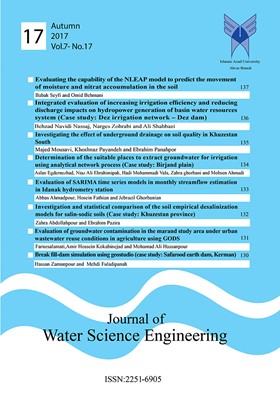Integrated Evaluation of Increasing Irrigation Efficiency and Reducing Discharge Impacts on Hydropower Generation of Basin Water Resources System(Case Study: Dez Irrigation Network – Dez Dam)
محورهای موضوعی : Irrigation and Drainage
بهزاد نویدی نساج
1
![]() ,
نرگس ظهرابی
2
,
علی شهبازی
3
,
نرگس ظهرابی
2
,
علی شهبازی
3
1 - دانشجوی دکترا، گروه علوم و مهندسی آب، واحد اهواز، دانشگاه آزاد اسلامی، اهواز، ایران.
2 - دانشگاه آزاد اسلامی واحد اهواز
3 - مدیر دفتر مدلهای آب و محیط زیست، سازمان آب و برق خوزستان، اهواز، ایران
کلید واژه: Improvement Irrigation Efficiency, reducing Inflow, Hydropower Generation, WEAP, افزایش راندمان آبیاری, کاهش آورد, هیدروانرژی,
چکیده مقاله :
World electricity production today is heavily dependent on water resources. Studies have shown that global warming and climate changes will have significant impacts on available water resources to produce hydroelectric power. Considering that the reservoir dam in the catchment area of Dez is simultaneously a producer of hydropower and supplier of water needed for agricultural land, the aim of this study is to estimate the quantitative effect of improving the efficiency of irrigation networks and reduce inputs to the dam on the amount of annual hydropower generation by the Dez dam power plant. For this purpose, with the integrated simulation of the Dez basin to Bandeghir, the effects of improving the efficiency of 5, 10, 15 and 20 percent, as well as decreasing the river inputs at 5 and 10 percent in two short- and long horizons, were studied. The results of this study showed that in the long run, as a result of the increased demand and the increase of hydraulic structures that are now at the justification stage, the amount of hydropower generation is reduced by about 115 GWh. The results showed that improving the efficiency can increase the amount of hydropower generation between 2 and 6 GWh per year. The production of hydroelectricity was highly dependent on the Dez River inputs, so that in the scenarios, a sudden drop in hydro-energy production occurred and the amount of it decreased by 5 and 10 percent, by 140 and 296 GWh, respectively.
امروزه تولید برق جهان به شدت به منابع آب وابسته شده است. مطالعات صورت گرفته نشان میدهد که بروز گرمایش جهانی و تغییرات اقلیمی اثرات بسیار مهمی را بر منابع آب موجود به منظور تولید انرژی برقابی به همراه خواهند داشت. با توجه به اینکه سد مخزنی دز واقع در حوضه آبریز دز به صورت همزمان تولید کننده هیدروانرژی و تامین کننده آب مورد نیاز اراضی کشاورزی پاییندست میباشد، هدف پژوهش حاضر برآورد میزان کمی اثر بهبود راندمان در شبکه های آبیاری و کاهش آورد به سد دز بر مقدار هیدروانرژی تولیدی سالانه در سد نیروگاه دز میباشد. به این منظور با شبیهسازی یکپارچه حوضه آبریز دز، اثر اعمال بهبود راندمانهای 5، 10، 15 و 20 درصد و همچنین کاهش آورد رودخانه دز در سطح 5 و 10 درصد در دو افق زمانی کوتاه و بلندمدت مورد مطالعه قرار گرفت. نتایج این تحقیق نشان داد که در بلندمدت به تبع افزایش نیاز و افزایش سازههای هیدرولیکی، میزان هیدروانرژی در حدود 115 گیگاوات ساعت کاهش مییابد. نتایج همچنین نشان داد که بهبود راندمان میزان هیدروانرژی را بین 2 الی 6 گیگاوات ساعت در هر سال افزایش میدهد. در تحلیل نتایج میزان هیدروانرژی تولیدی وابستگی شدیدی به آورد رودخانه دز داشت به طوری که در سناریوهای کاهش آورد، افت یکباره در تولید هیدروانرژی رخ داده است و میزان آن به ازای کاهش آوردهای 5 و 10 درصد به ترتیب 140 و 296 گیگاوات ساعت کاهش یافته است.


